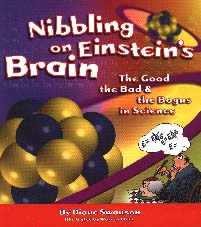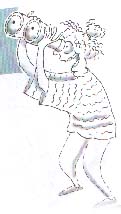| ________________
CM . . .
. Volume VIII Number 11 . . . . February 1, 2002
exerpt:
For a mere $16.95, for the paperback version, a reader can indulge in repeat trips to the savory buffet of scientific reasoning served up by Diane Swanson in Nibbling on Einstein's Brain: The Good, the Bad & the Bogus in Science. By filling the book with references to common experiences -- everything from dentists to dish soap, breakfast cereal to blood circulation, car collisions to cough syrup, roadkill to rashes -- Swanson impresses upon readers that science "is not just a mountain of discoveries and a mass of facts," but rather "a way of figuring things out and evaluating information" (p. 5). The book introduces "scientific method" to its readers, encouraging them to exercise a healthy portion of skepticism, and to develop their critical thinking skills, so that they can better evaluate "the good, the bad and the bogus."
Sandwiched
between the tastefully designed covers, which portray atomic structures
(staple icons of science) against a background blend of primary colors,
are five chapters that emphasize the many ways science impacts one's
everyday life. Chapter one spotlights a few examples of bad science
and flawed research, such as that which led to Radiothor, a harmful
radioactive concoction marketed as "medicine" in the 1920s.
This chapter, however, also recounts the many benefits of science. It
explains the differences between five main scientific disciplines and
identifies five principles to foster good scientific practices, thereby
whetting readers' appetites for the "main course" represented
by the three subsequent chapters. "Science Watch," for example,
introduces 21 "Baloney Busters" -- ways to challenge the research,
analysis, and conclusions of experimental findings according to "scientific
method." "Media Watch" then follows up with 11 considerations
readers should keep in mind when they review scientific reporting and/or
critique advertisements promoted in the media. Finally, "Mind Watch"
teaches readers to think past hearsay, preconceptions, proverbial wisdom,
superstition, and circular reasoning before they accept or reject scientific
breakthroughs. Chapter five concludes with a light summary of strategies
readers may use to defend themselves against bad science. As far as overall presentation is concerned, Nibbling on Einstein's Brain wins points from this reviewer for its attractive layout. The book consists mainly of black type, and black and white cartoon illustrations, with teal green-shaded accents. Pages are reminiscent of collage, since they contain philosophical bites in speech/thought balloons, various font styles, and angled blocks of text. Delectable tidbits of quotations from members of the scientific community grace many pages, while "your turn" sections sprinkled throughout give readers something to chew over. Here, the book presents readers with commonplace scenarios to which they may apply what they have learned. ("Solutions" are provided on p. 100.) Only two minor things prove to be disappointing: the Table of Contents collapses in on itself like a fallen cake, in disregard of the text's repeated appeal to order and clarity; additionally, the illustrations, although amusing, are more decorative than functional, and not as "satirical" as the accompanying "Press Release" leads one to believe. Additional aids that will help readers digest scientific information have been well thought out and strategically placed. Each chapter, for instance, concludes with a checklist summarizing the key points addressed therein. A section entitled "Where to Get Help" lists magazines, Internet sites, and books that one can consult for further information. A glossary and an index direct readers to the definitions and/or locations of specific terms. Furthermore, within the text itself, much internal cross-referencing occurs. With the release of Nibbling on Einstein's Brain, Annick Press continues its tradition of publishing books that promote dialogue, that nudge readers to respond as a result of reading. This underlying intent is especially evident in the use of the second-person, which places the onus upon the reading "you." Although language and sentence structure are relatively simple to comprehend, the content seems better suited to children ages 10-14 than to those ages 8-12 (the age range the book's "Press Release" assigns), for it begs a reader sophisticated enough to be cognizant of his/her own reasoning processes and motivations, as well as those of others, be they individuals or organizations. On the whole, the book is effectively organized, and successfully educates in an entertaining manner. The variety of visual stimuli it contains should give it a competitive edge in capturing readers' attention. Since it urges readers to ask questions to increase their "scientific literacy," and given the fact that it lists a number of resources to consult towards that end, Nibbling on Einstein's Brain seems ideally suited as a book not only for the true young science buff or media critic, but also for those young persons who may already be scraping together ideas for next year's science fair project. Teachers, parents, librarians, and other adults who want to make science attractive to young people will snap up Nibbling on Einstein's Brain with gusto. Highly Recommended. Julie
Chychota has an M.A. in English Lit. and is currently taking courses
in Library Studies.
To comment on this
title or this review, send mail to cm@umanitoba.ca.
Copyright © the Manitoba Library Association. Reproduction for personal
use is permitted only if this copyright notice is maintained. Any other
reproduction is prohibited without permission.
Published by
NEXT REVIEW |TABLE OF CONTENTS FOR THIS ISSUE - February 1, 2002.
AUTHORS
| TITLES | MEDIA REVIEWS
| PROFILES
| BACK ISSUES
| SEARCH | CMARCHIVE
| HOME
|

